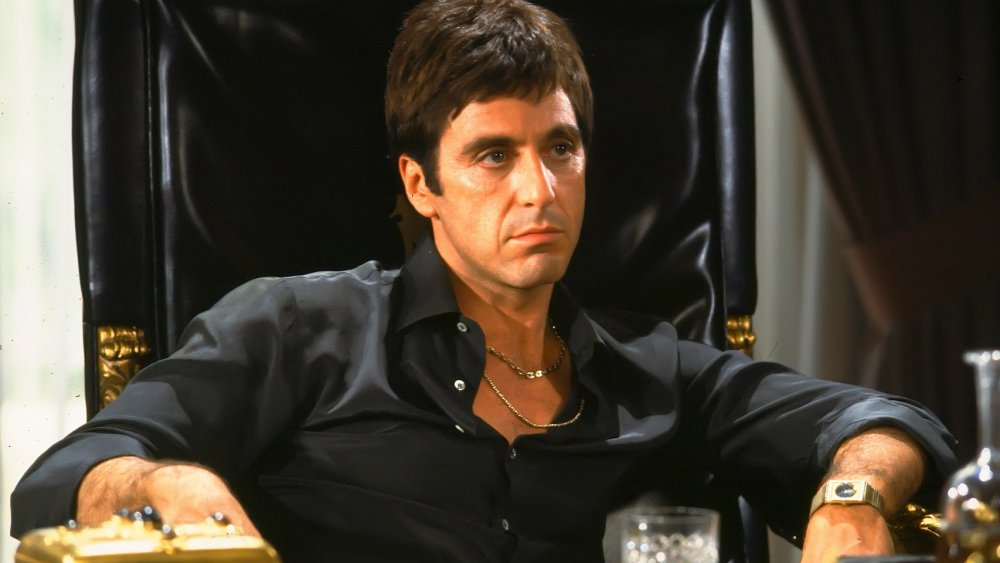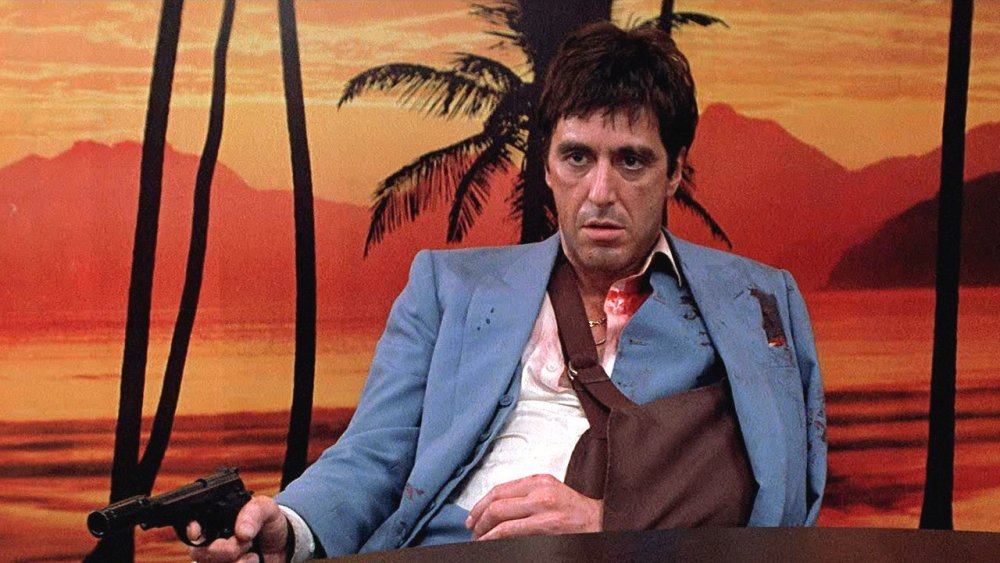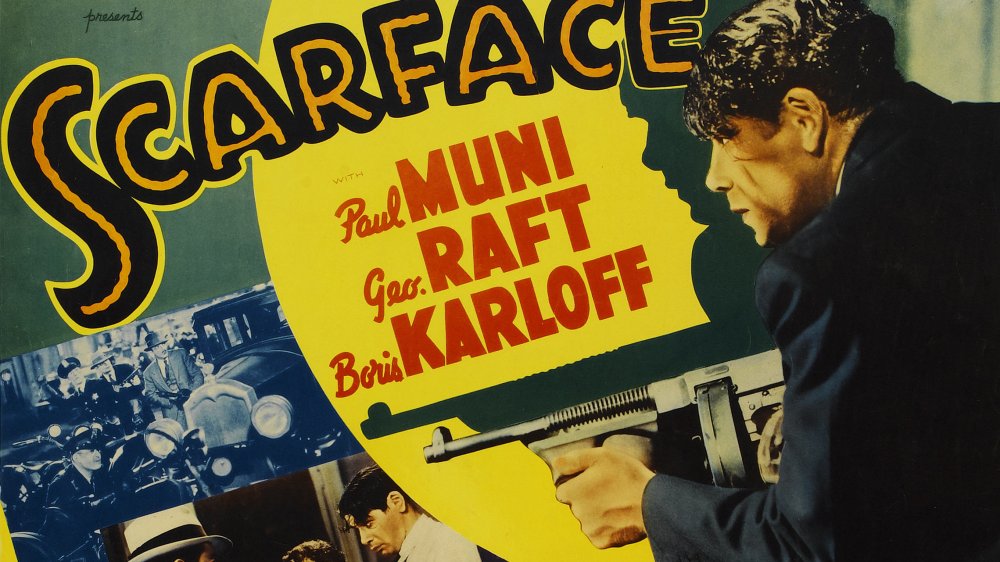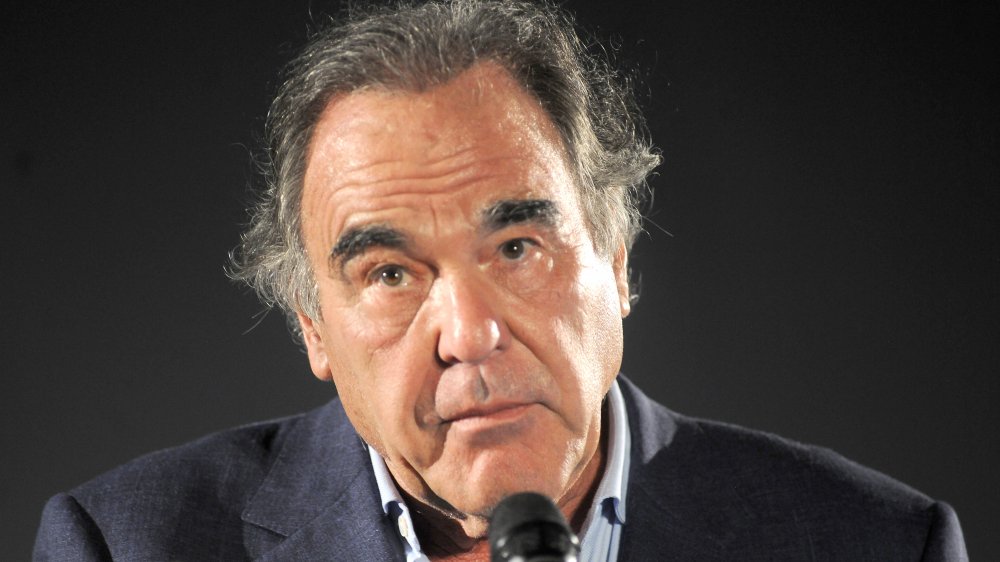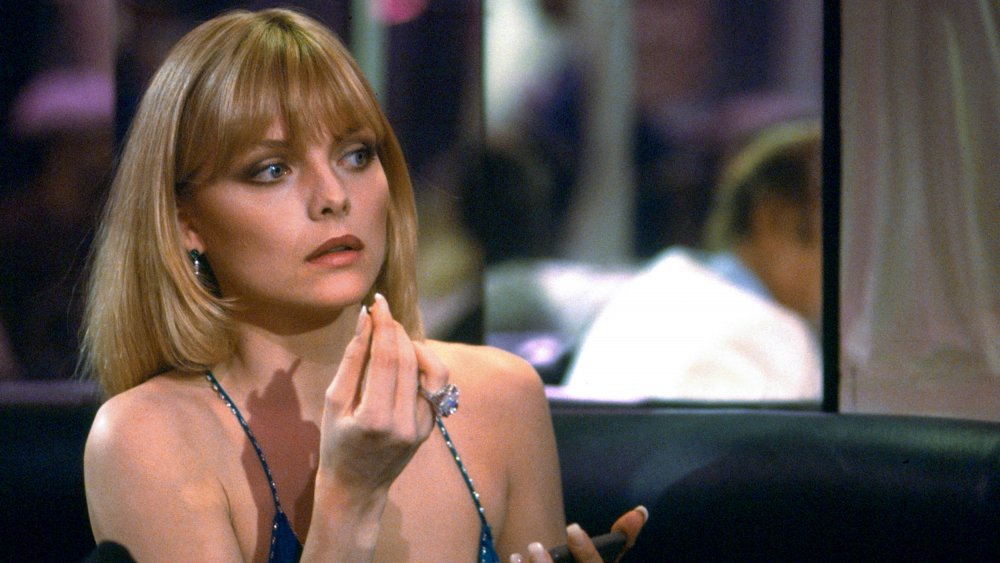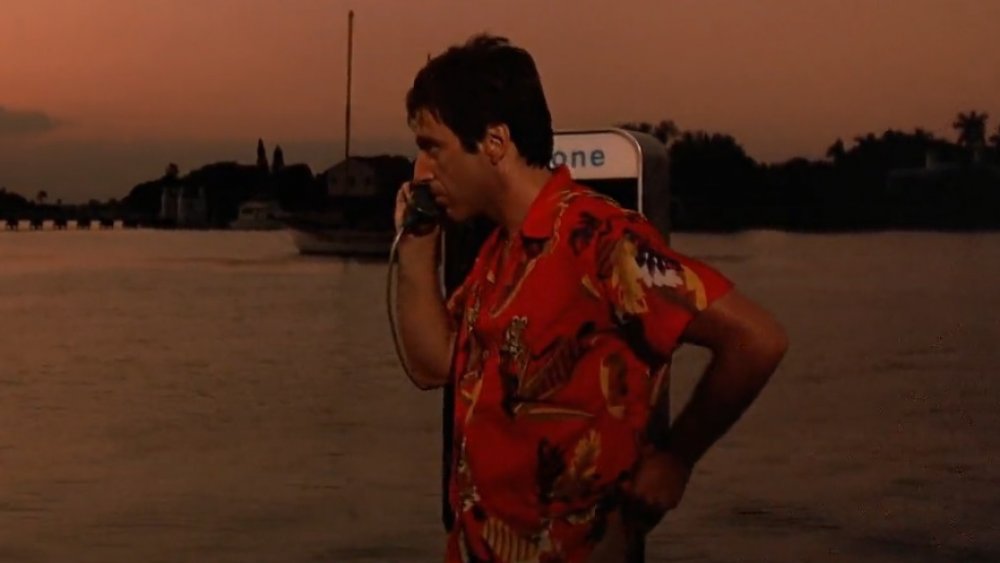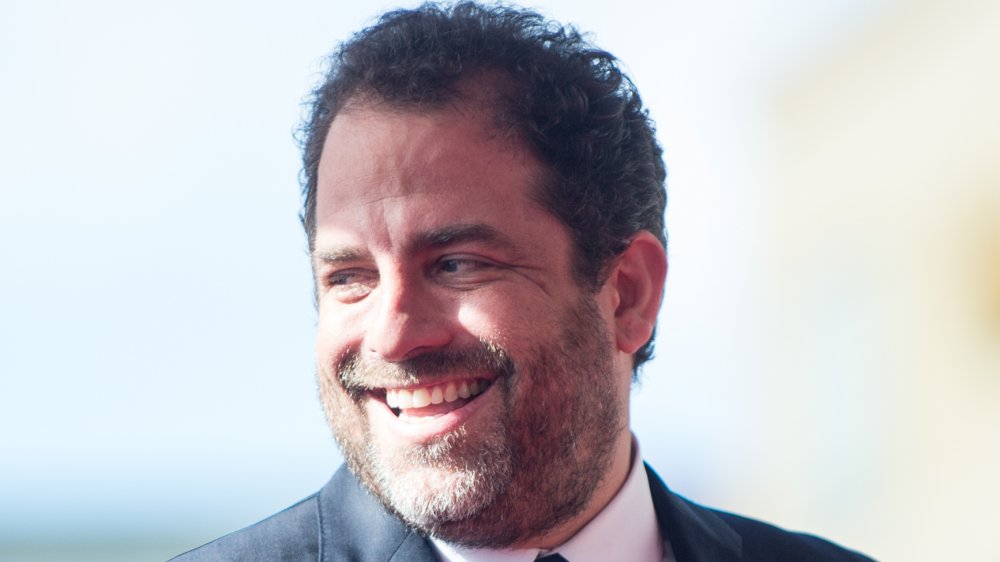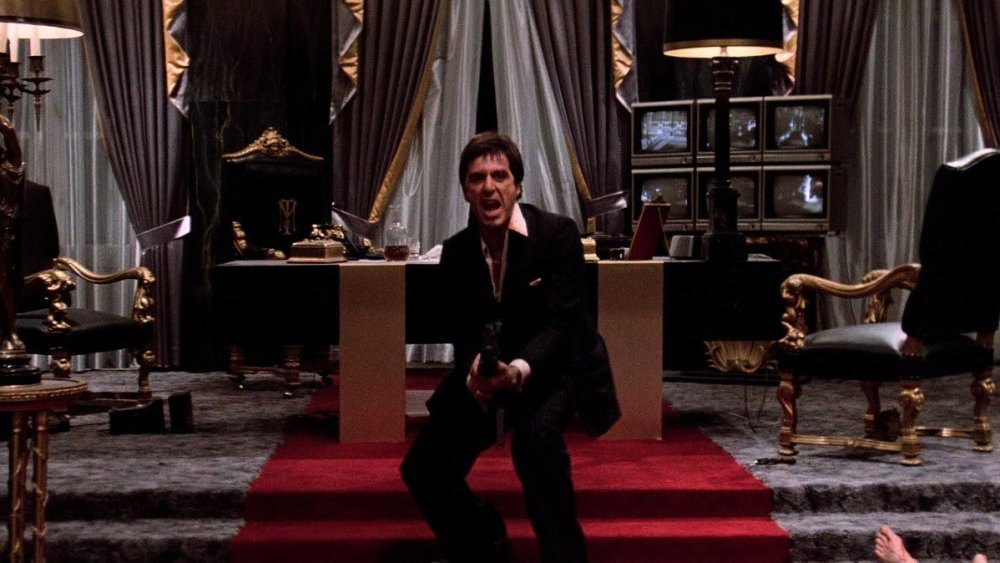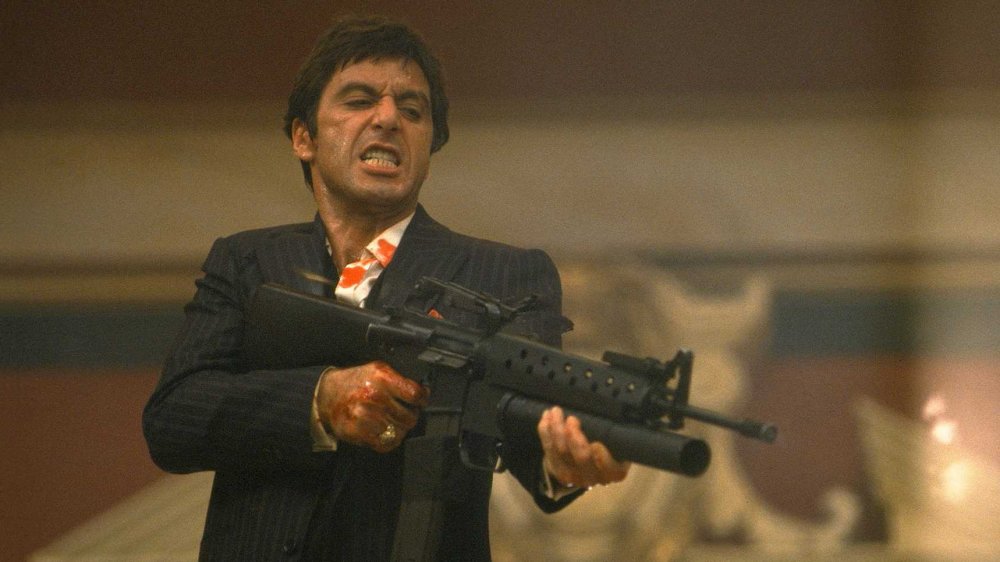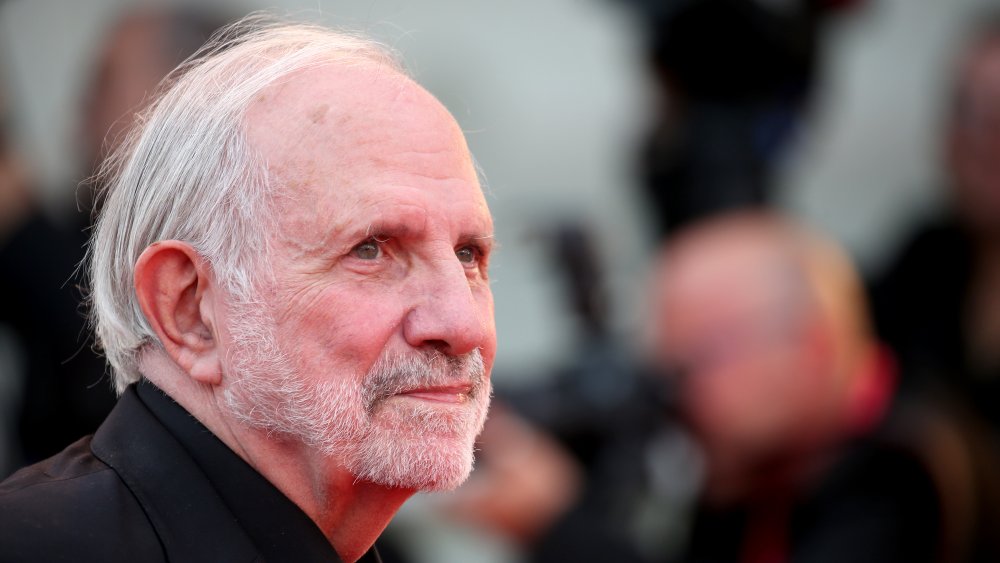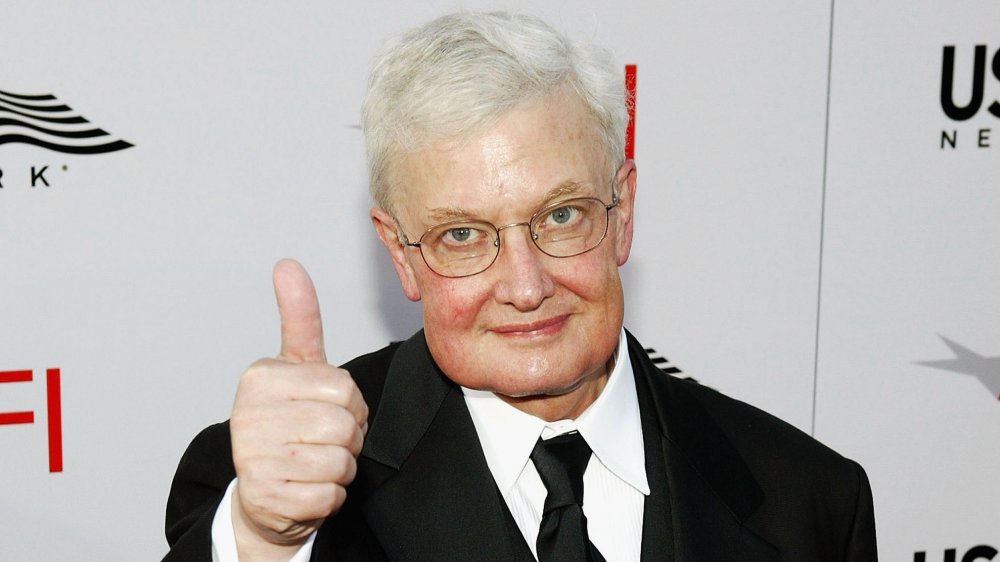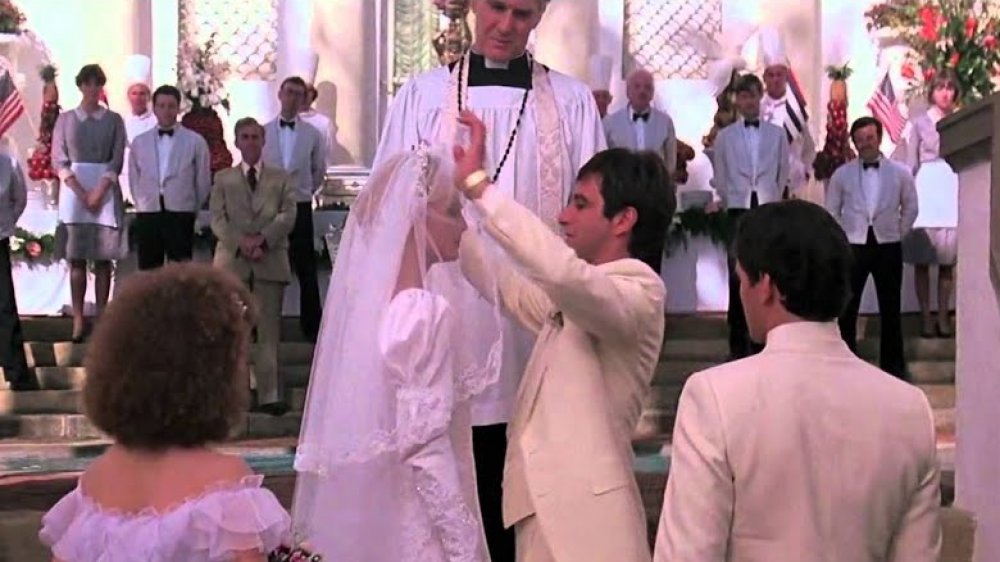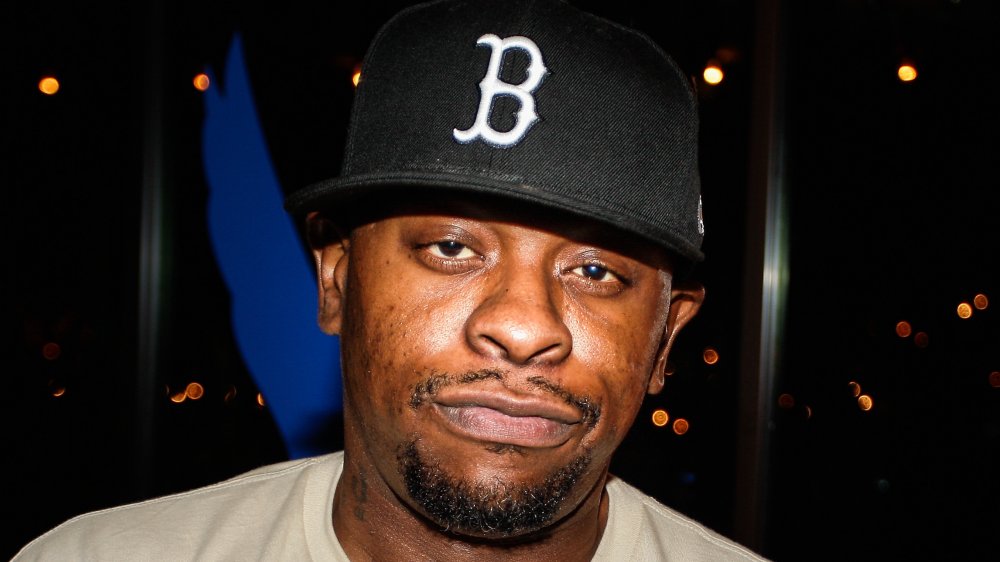The Untold Truth Of Scarface
In 1983, director Brian De Palma and writer Oliver Stone dropped a movie that the world was in no way ready for — Scarface, a retelling of the classic immigrant gangster tale first brought to the silver screen by Howard Hawks in 1932. The new flick shifted the action from Chicago to Miami, and at its center was a character who would become one of the most infamous in all of cinema. That's right, we're talking about Tony Montana (Al Pacino), who came to the U.S. in the Mariel boatlift of 1980 and whose idea of the American dream was to have the world at his feet, at the expense of anyone and anything who stood in his way.
Pacino's performance in the film has become the stuff of legend, and it was bolstered by an excellent supporting cast full of current and future stars such as Michelle Pfeiffer, Robert Loggia, Mary Elizabeth Mastrantonio, and F. Murray Abraham. But thanks to its astonishing level of violence and its nihilistic worldview, it's been controversial since the day it was released. At the film's premiere in December 1983, the celebrity audience was split right down the middle. Model Cheryl Tiegs, for example, said, "[It's] the most violent film I've ever seen. It makes you never want to hear the word 'cocaine' again." Cher, on the other hand, had a different take. "I really liked it," she said. "It was a great example of how the American dream can go to s**t."
The film's edges haven't softened over the years, nor has it grown any less divisive. Here's the untold truth of one of the greatest, bloodiest, most influential films of all time — Scarface.
Scarface was Al Pacino's idea
The movie that came to largely define Al Pacino's career likely would never have happened if he'd just stayed home instead of going out to take in a flick one night. Speaking with author Lawrence Grobel for the retrospective that accompanied Scarface's Blu-ray release, Pacino explained that the reputation of Hawks' original 1932 picture had always intrigued him, and he lucked into a screening one night in L.A.
"I had heard about Scarface for a long time," Pacino said. "It was the model for all gangster pictures. When I saw it, it had a real feeling to it, a grand feeling, and it had a great performance by Paul Muni. He did something different. I thought it would be interesting to do a remake of this, in another way. So I called [producer] Marty Bregman, and he saw it and got very excited." And the rest, as they say, is history.
It was almost a period piece
Producer Marty Bregman originally wanted Sidney Lumet, who'd directed Pacino in Dog Day Afteroon, to make the movie. He also attempted to secure the services of Oliver Stone to write the screenplay, but initially, Stone wasn't interested. In an interview with Creative Screenwriting, he explained, "I didn't like the original movie that much, it didn't really hit me at all, and I had no desire to make another Italian gangster picture because so many had been done so well, there would be no point to it."
Stone then explained what had changed his mind — a brilliant idea by Lumet to update the film's setting. Pacino and Bregman had both envisioned the project as a period piece, more of a straight remake of the original, but Lumet saw the story's potential to translate well to what what was going on in Florida at the time. "Sidney had a great idea to take the 1930s American prohibition gangster movie and make it into a modern immigrant gangster movie dealing with the same problems that we had then, that we're prohibiting drugs instead of alcohol," Stone said. "It was a remarkable idea. The Marielitos [Cuban immigrants] at the time had gained a lot of publicity for their open brazenness. ... They were deported by Castro in 1981 to America. At the time it was perceived he was dumping all the criminals into the American system."
Stone and Bregman proceeded to conduct research on the rocky relationship between the Marielitos and the communities of Southern Florida, and Stone also traveled to the Caribbean to document aspects of the drug trade, which he said was an interesting time. "There's no law down there," Stone explained. "They'll just shoot you in your hotel room. It got hairy."
Oliver Stone wrote Scarface from experience
In 2015, Stone spoke with Sabotage Times about his experience researching Scarface. As it turned out, he was at once one of the more qualified Hollywood screenwriters that producer Marty Bregman could've picked to tackle the subject and also the last man who should've been diving head first into the drug trade. "I was a cocaine addict for about two and a half years prior to writing Scarface," Stone said (via The Independent). "I knew that world, the drug world of the early '80s very well."
As a result, Stone's research had been conducted at a torrid pace, but when it came time to actually write a draft, a change of scenery was in order. He decided to move to Paris — where he knew that getting access to the drug would be difficult — to knock out the screenplay for Scarface. Speaking with Empire, the screenwriter said, "I was doing cocaine during the research phase but then went cold turkey during the writing in Paris. I knew I couldn't break the habit in Florida, LA, or New York."
Nobody wanted to cast Michelle Pfeiffer
Michelle Pfeiffer has been one of the biggest movie stars in the world for so long that it's easy to forget that there was ever a time when she wasn't. But at the time Bregman and Brian De Palma (who'd replaced the departed Sidney Lumet by this point) were casting Scarface, she had only appeared in TV movies, popped up in guest roles in series like CHiPs and Fantasy Island, and starred in a handful of minor features (one of which was the much-maligned Grease 2). Bregman had his sights on her for the part of Elvira, Tony's drug-addled but sharp-witted trophy wife, from the beginning — but he was the only one. Pacino preferred Glenn Close, while De Palma and Bregman auditioned a laundry list of the hottest actresses in Hollywood at the time.
Among those to turn the part down were Kim Basinger, Melanie Griffith, and Rosanna Arquette. Carrie Fisher, Sharon Stone, and Geena Davis all auditioned, but they failed to land the role. In the end, Bregman won out, and while Pfeiffer may have been a relative unknown, her star power is obvious in the part.
Scarface wasn't entirely shot in Miami
Scarface might've offered the definitive portrait of the neon-soaked, drug-choked streets of Miami in the early '80s, but believe it or not, the flick was only partially shot on location. The city of Miami wanted nothing to do with the movie, as officials feared it would depict the city as a haven for organized crime and the drug trade. Bregman, for his part, was unmoved by their protests. "It already has that image," he shot back during one round of talks.
The crew shot for only 12 days in Miami, mostly exteriors and pickup shots, and De Palma would later say that it felt like they had been run out of town. Bregman moved the production to LA for the bulk of shooting, and many of the flick's most famous scenes — including the opening Freedom Town riot and the massive shootout at Tony's mansion at the film's end — were shot there. One scene that was shot in Miami was the infamous "chainsaw scene," in which Tony's friend Angel (Pepe Serna) is murdered in the bathroom of a seedy apartment. The shoot took place at an actual apartment building on Ocean Drive in Miami, one which (as you can probably imagine) regularly attracts throngs of film fans even today. The exterior of the building was even preserved when it was converted to a CVS in 2017.
There's a cameo from a future famous director
It ended up being quite fortuitous for at least one future filmmaker that Scarface was forced to shoot mostly around Miami. Not that you'd recognize him, but in the background of the scene at the pool — the one in which Tony gives Manny (Steven Bauer) the "first, you get the money, then you get the power" speech — a very young Brett Ratner, just a schoolboy at the time, can be seen.
Speaking with Variety in 2007, Ratner credited the experience with solidifying his decision to become a film director. "I was on the set of Scarface — I skipped school to go to the set every day and watch them shoot," Ratner remembered. "And I saw Brian De Palma telling Al Pacino what to do, and Al Pacino doing what the director told him to do." Ratner went on to recall that years later, he bumped into Pacino and told him, "I was on the set when you shot Scarface, and it's because of you that I became a director." When Pacino asked him why that was, Ratner replied, "Because I saw you act, and I could never be that good, so I wanted to be the guy who told you what to do."
Now, whether or not that was a good thing, well ...
Steven Spielberg directed one shot in the climactic gunfight
The final few minutes of Scarface feature one of the most epic gunfights of all time — a scene that's so insane and bloody that even hardcore fans could be forgiven for not catching the sneakiest of all cameos amid the chaos. That's because it happened not in front of the camera but behind it.
De Palma was good buddies with a director you might've heard of, a guy named Steven Spielberg, who just the year before had fielded what was then the highest-grossing picture in history in E.T. the Extra-Terrestrial. Spielberg dropped by the Scarface set during one of the days the climax was being filmed, and — apparently just for grins — De Palma had him direct one single shot, the one in which Tony's attackers first gain entrance to the mansion (right before they say hello to his little friend). If it seems a little shocking that Spielberg would be involved in a scene of such total carnage, we'd like to remind you about a little film called Saving Private Ryan, the opening scene of which puts Tony's massacre of the invading thugs to shame.
Pacino injured himself while filming
The infamous mansion scene is one of the craziest movie climaxes ever put to film. And it's also notable for another reason. While filming the gunfight, Pacino injured himself so badly that it threatened to shut down the entire shoot. Considering all of the hot lead that appears to be flying in that scene, the way in which he hurt himself shouldn't come as too much of a surprise. He tripped and accidentally grabbed the barrel of a gun that had just been fired somewhere in the neighborhood of 30 times. At a 2011 party celebrating the flick's Blu-ray release in 2011, Pacino recalled that his hand "stuck to that sucker" (via The Independent).
Pacino was carted off to the nearby Sherman Oaks Burn Center, where he was attended to by the same doctor who'd seen Richard Pryor after the famous incident in which the storied comic set himself on fire. The injury kept Pacino out of action for over a week, and there was even more bad luck. While the production was picking up scenes in his absence, two stunt performers were hurt when a bomb went off prematurely.
Scarface was rated X three times
Not many films have ever been rated X for violence, but in the '80s, several pictures came close — and Scarface was among them. The MPAA ratings board weren't exactly taken with the picture as a whole, but as you might have guessed, it was that incredibly horrific scene with the chainsaw that caused them to initially slap the film with the X. After two rounds of cuts to the scene, the ratings board were unmoved, sticking with their rating ... and forcing De Palma to threaten to quit. Rather than bring in a different director to cut the film, Universal Pictures appealed the board's decision.
Amazingly, they won the appeal, but then De Palma spoke up. The changes he had made from the original cut were so slight, he argued, that he should be able to restore them and still get the R rating. The board disagreed and required him to keep the cuts, but De Palma got the last laugh. In a 2013 interview with The Talks, the director said, "I was able to beat the ratings board with Scarface. Even though they rated it X, I was able to appeal to the whole committee, and we got it passed. There's a lot of controversy about how Scarface was edited, but in reality, everything I cut out to appease the rating board I put back in, and that's what you see."
That's pretty darned sneaky, but when you watch the scene, it's obvious how he was able to pull that off. It's probably not nearly as graphic as you remember, especially since most of the horror happens offscreen. It's just so intense that it kind of seems like it's super gory.
Some critics hated the movie
It may not shock you to know that upon Scarface's release, a goodly number of critics were absolutely disgusted with the movie. For example, in its review, People magazine trashed Scarface mercilessly. "Characterization and plot go out the window. Arms are cut off with chainsaws. By the third hour, everything is out of control," it read. "The bloodbath that ends the film is an insult to everything De Palma has done before. There is no style to this violence; everything seems to be in service of an Oscar-stalking Pacino performance. His acting isn't acting; it's shameless showing off. So is the movie."
While the flick has obviously undergone a critical reappraisal in the intervening years, that napalming was fairly typical of reviews of the time. The great Roger Ebert, of course, saw the film for what it was. In his four-star review, he wrote, "Scarface understands this criminal personality, with its links between laziness and ruthlessness, grandiosity and low self-esteem, pipe dreams and a chronic inability to be happy. It's also an exciting crime picture, in the tradition of the 1932 movie. ... [It's] a wonderful portrait of a real louse."
That song has taken on a life of its own
Scarface is a film that is very much of its time, and this is never more true than in the infamous montage sequence that occurs roughly midway through the picture. As Tony builds his empire and begins rolling in the dough, we're regaled with the insanely cheesy, disco-y strains of "Scarface (Push It to the Limit)," which was co-written and produced by electronic music king Giorgio Moroder and performed by Paul Engemann.
The song is such pure, distilled cheese, and the sequence in which it appears is so absurdly typical of '80s montage sequences that it has become something of an inside joke. It's been used to comedically score similar montages in shows like South Park (in the episode "Up the Down Steroid"), It's Always Sunny in Philadelphia (in the episode "Mac's Big Break"), and American Dad! (in the episode "The Boring Identity").
It's also been parodied countless times. Going back to the Scarface well, South Park also took that route, employing an extremely similar original tune that was actually called "Montage" in the episode "Asspen." So spot-on is the song that creators Trey Parker and Matt Stone even used it again in the 2004 feature film Team America: World Police.
Scarface's long relationship with music
Today, Scarface is considered to be a classic and one of De Palma's best films, but it likely wouldn't enjoy this reputation if not for a huge assist from the rap genre. Rap artists immediately took to the film. It was released the same year as Grandmaster Melle Mel's "White Lines," a thematically similar work, and it's become inextricably linked with rap, sampled dozens of times and referenced hundreds more. Perhaps the earliest adopters were the first incarnation of Houston crew Ghetto Boys (later known as Geto Boys), who extensively sampled dialogue from the film on their 1988 debut album Making Trouble. The trend would continue through the name change and a massive shakeup in the group's lineup, and one of the group's rappers even goes by the moniker — you guessed it — Scarface.
In particular, the iconic line "say hello to my little friend" from the final shootout has been firmly cemented in the public consciousness almost solely due to its having been sampled six ways from Sunday, and it almost goes without saying that rap's fascination with the movie has gone a long way toward helping it remain in the public consciousness. When Scarface was released on DVD in 2003, it logged the most advance orders ever, beating out the previous champ — Spielberg's E.T. the Extra Terrestrial.
